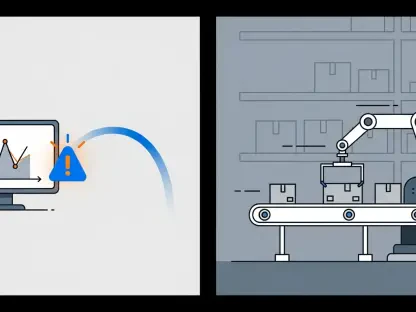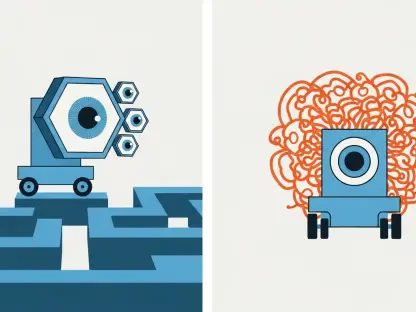The realm of AI agent testing is witnessing a seismic shift as developers and researchers grapple with the challenge of evaluating autonomous systems in real-world, terminal-based environments. With over 60% of modern developer workflows relying on command-line interactions, the demand for robust benchmarking tools has never been higher. This roundup dives into the recent release of Terminal-Bench 2.0 and Harbor, two groundbreaking tools designed to redefine how AI agents are assessed and optimized. By gathering insights from industry professionals, academic researchers, and tech communities, this discussion aims to uncover the impact, potential, and varied perspectives surrounding these innovations.
Unveiling Diverse Perspectives on AI Evaluation Tools
Terminal-Bench 2.0: A Step Forward or a Niche Focus?
Terminal-Bench 2.0 has emerged as a refined benchmark suite with 89 validated tasks tailored for terminal-based AI agent testing. Many developers commend its emphasis on clarity and relevance, noting that the updated tasks address previous inconsistencies by eliminating unstable dependencies. Community forums highlight how this precision enhances reliability, making it a valuable asset for those focused on real-world applicability.
However, not all feedback is unanimously positive. Some industry voices argue that the increased difficulty and narrow focus on quality might deter broader adoption among smaller teams or startups lacking resources for complex testing. A segment of testers suggests that while the benchmark sets a high standard, it may not fully cater to diverse use cases outside specialized developer environments.
Balancing these views, a consensus emerges that Terminal-Bench 2.0 represents a significant leap in standardized evaluation, though its accessibility remains a point of debate. Discussions in tech circles emphasize the need for complementary resources or simplified entry points to ensure inclusivity across varying levels of expertise.
Harbor: Scalability Meets Versatility in AI Testing
Harbor, a runtime framework introduced alongside Terminal-Bench 2.0, has garnered attention for its ability to manage thousands of cloud containers for agent training and evaluation. Industry insiders praise its scalability, pointing to its internal use during benchmark development as proof of handling massive rollouts. Many see it as a game-changer for supporting diverse agent architectures across major cloud platforms.
On the flip side, concerns about cloud dependency and integration challenges surface in online panels. Some developers express apprehension over potential costs and technical hurdles, especially for organizations with limited infrastructure. These critiques underline a broader worry about whether Harbor’s advanced capabilities might exclude smaller players in the AI space.
Despite these reservations, a growing number of early adopters advocate for Harbor’s flexibility, highlighting its documentation and public leaderboard features as democratizing tools. Feedback from user groups suggests that while barriers exist, the framework’s adaptability offers a strong foundation for future-proofing AI testing needs.
Performance Metrics and Industry Trends
Leaderboard Insights: Competition and Challenges
Initial leaderboard results for Terminal-Bench 2.0 reveal a tight race among top AI models, with success rates hovering between 42.8% and 49.6%. Industry analysts note that this clustering reflects intense competition, yet also exposes the persistent difficulty of terminal tasks, as no agent surpasses the 50% mark. This data sparks discussions on whether current metrics adequately capture agent potential.
Differing opinions arise on the value of success rates alone. A faction of researchers argues for deeper qualitative analysis of failures to uncover actionable insights, while others maintain that raw performance numbers remain critical for benchmarking progress. This divide illustrates an evolving conversation about evaluation depth in the AI community.
Regional adoption patterns also vary, with some areas showing rapid uptake due to strong developer ecosystems, while others lag behind. Commentators suggest that targeted outreach and localized support could bridge these gaps, ensuring that tools like Terminal-Bench 2.0 resonate globally across diverse tech landscapes.
Reproducibility as a Growing Priority
The push for reproducible testing environments dominates current discourse, especially as large language models become integral to developer workflows. Many experts stress that inconsistent evaluation setups hinder progress, applauding Harbor’s containerized approach for offering stability. This sentiment echoes across academic and industry blogs, signaling a unified call for standardization.
Yet, challenges in aligning reproducibility with practical deployment persist. Some practitioners caution that overly rigid frameworks might stifle innovation, advocating for a balance between consistency and creative experimentation. This tension highlights a nuanced debate on how best to structure testing protocols without constraining flexibility.
Feedback from collaborative platforms points to community-driven solutions, such as shared guidelines and open-source contributions, as vital for advancing reproducible practices. These inputs suggest that collective efforts could shape the next phase of AI evaluation, ensuring tools remain both reliable and adaptable.
Bridging Gaps: Research and Real-World Applications
Academic and Industry Synergy
Terminal-Bench 2.0 and Harbor together form a cohesive ecosystem, blending academic rigor with industry needs. Scholars in AI research forums appreciate the methodological depth of Terminal-Bench tasks, viewing them as ideal for studying agentic reasoning. Meanwhile, corporate testers value Harbor’s scalability for streamlining operational rollouts, showcasing a rare alignment of goals.
Contrasting opinions surface on the pace of integration into existing workflows. While some academic circles call for gradual adoption to refine methodologies, industry stakeholders push for rapid deployment to meet market demands. This discrepancy underscores the differing priorities between theoretical exploration and practical outcomes.
A middle ground appears in community suggestions for joint initiatives, such as workshops or shared documentation, to foster collaboration. These ideas hint at a future where dual tools like these could unify disparate sectors, creating a more interconnected AI development landscape.
Community Collaboration and Public Engagement
Public leaderboards and accessible resources tied to these tools receive widespread acclaim for encouraging transparency. Many in the open-source community view these features as catalysts for collective learning, allowing developers to benchmark and compare results openly. This openness is often cited as a strength in driving innovation.
However, skepticism exists about the inclusivity of such platforms. A subset of independent developers notes that leaderboard participation might favor well-funded teams, potentially sidelining smaller contributors. This concern prompts calls for tiered evaluation systems to level the playing field.
Despite these challenges, the overarching sentiment leans toward optimism. Tech meetups and online discussions reveal a shared belief that fostering community engagement through accessible tools can democratize AI testing, paving the way for broader participation and diverse perspectives.
Actionable Takeaways from the Roundup
Reflecting on this roundup, the insights gathered paint a multifaceted picture of Terminal-Bench 2.0 and Harbor’s impact on AI agent testing. The refined benchmarking of Terminal-Bench 2.0 elevates standards, while Harbor’s scalable infrastructure tackles large-scale evaluation needs, as echoed by various industry and academic voices. Differing views on accessibility and metrics reveal a dynamic field poised for growth, yet hungry for balance between precision and inclusivity.
Looking back, the discussion underscores actionable steps that stakeholders can take to navigate this evolving landscape. Developers are encouraged to leverage Harbor’s custom benchmark creation for tailored testing, while integrating Terminal-Bench tasks into existing pipelines offers a practical starting point. Exploring public leaderboards provides a benchmark for progress, and tapping into community resources helps bridge knowledge gaps, setting a foundation for continued advancement in AI agent capabilities.









